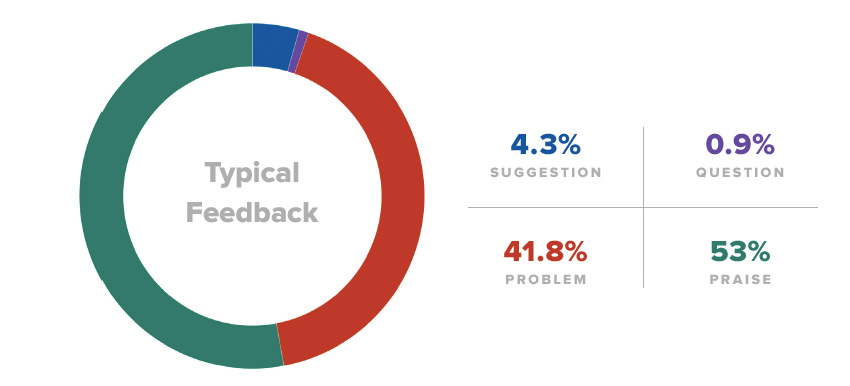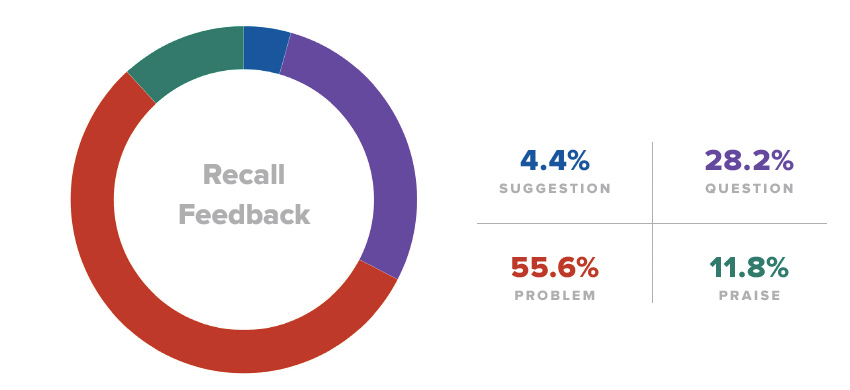Text analytics platforms can empower big manufacturing companies to quickly assess their customers’ expectations, possible miscommunication issues, and the impact the company’s actions on customer sentiment. This approach to crisis management enable businesses to seamlessly align internally and to place their customers at the centre of their product recall strategy.
For instance, one of our clients detected a safety risk in one of their products and issued a product recall that affected 15,000 customers. When their customer experience manager, John, learned that the company’s engineers estimated it would take several months to fix the problem, he knew his department needed to act fast to guide the organization in providing the best service to their customers during the crisis.
Due to the magnitude of the product recall, several departments were involved, each with their own objectives. To respond to these objectives and to influence the internal stakeholders to support his cause – the customer – John needed reliable data. Upper management wanted proof of the benefits before investing in compensation for the customer. Engineering needed to be persuaded that fixing the technical issues was the top priority. This data would also assist him in communicating the issues in a way that would help the customers by answering their questions.
AI does the heavy lifting
John had been promoting Customer Experience (CX) internally for almost four years. He had already built the Voice of the Customer (VoC) program, which included sending surveys to customers and franchise managers to ensure a consistent brand experience regardless of where the customers were buying from. As a result, when the recall crisis hit, he didn’t have to start from scratch.
Keatext machine learning algorithm transforms customer feedback into an easy-to-understand report that allows him to take the pulse of his customer base at a glance.
An important part of the feedback these surveys collect are answers to open-ended questions, which John values highly for their rich insights. However, it can be problematic to analyze a large volume of answers during crisis management, when speed is vital. To analyze this type of feedback, John had been using Keatext for the past three years.
Keatext machine learning algorithm transforms customer feedback into an easy-to-understand report that allows him to take the pulse of his customer base at a glance. That’s customer care! John used this report and his previous experience with Keatext to help him manage the situation. He decided he would distribute two different surveys to the affected customers and franchise managers at two different moments in the product recall. In this way he would understand their needs and strategize accordingly with internal stakeholders.
A bird’s eye view on customer care and sentiment
During the early days of the product recall, John sent out the first survey. To get a 3600 view of customer opinion, he also collected data from social media, forum discussions, Salesforce case requests, and call transcripts. He consolidated the data from these sources into Keatext.
Right away he could see something that didn’t surprise him: the Customer Sentiment Score, a unique Keatext customer satisfaction rating extracted directly from feedback, was 68% lower than in other surveys done in the past. Additionally, during those first days of the recall, the feedback in the four categories changed significantly. He now had tangible proof to present to his internal stakeholders that customers were unhappy.
A typical survey (Chart 1) has a higher percentage of Praises (positive comments) than Problems (negative comments), and includes a few Suggestions and Questions.

The first survey distributed during the product recall (Chart 2) showed more Problems than Praises, as customers wanted to have their products returned as soon as possible. John found the Question category particularly interesting, having realized he could use the customers’ questions to advise the legal team. Based on the insights he presented, the company’s legal and communications teams crafted a recall updates announcement in tune with customer interests and expectations.

After the recall updates announcement, John sent the second survey to the same customers and dealers. In the feedback, he found that the announcement had improved the Customer Sentiment Score by 29%, but the percentages of Praises, Problems, Questions, and Suggestions remained almost unchanged. However, thanks to the comments aggregation feature offered by Keatext, John could see that the content of the Questions had changed.
Before the updates announcement, multiple customers asked questions that communicated their desire for updates about the recall, phrasing their questions in similar ways. After the updates announcement, not only had the variety of questions increased, they had become more specific. John communicated these results to the legal and communications teams, and together they concluded that a Recall FAQ would be the most appropriate way to address the uncertainties the feedback revealed.
With Keatext, John was able to guide his organization through a difficult time with the help of the voice of the customer.
Another insight that surfaced was that franchise managers didn’t know how to help their customers. Using this data, John advocated for a program that empowered franchise managers to assist their customers by providing compensation such as warranty extensions.
With Keatext, John was able to guide his organization through a difficult time with the help of the voice of the customer. Using data to back up his recommandations, he ensured that his company served its customers with transparency, responsiveness, and most importantly, customer care and empathy.



